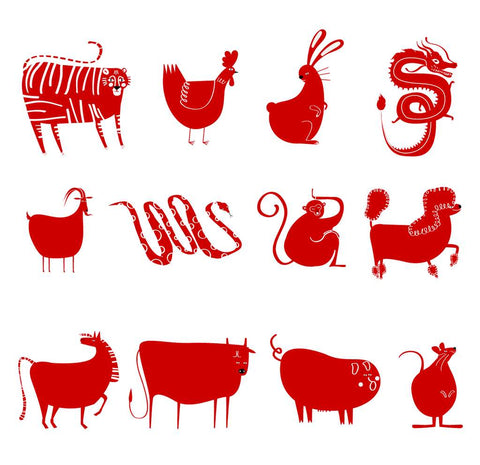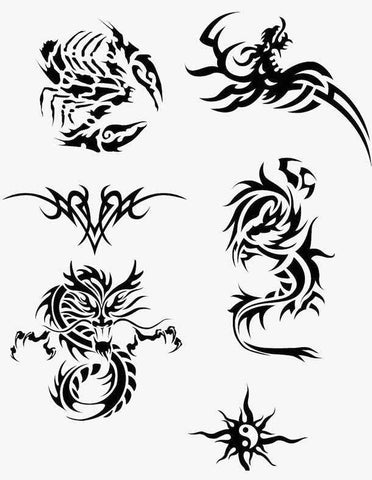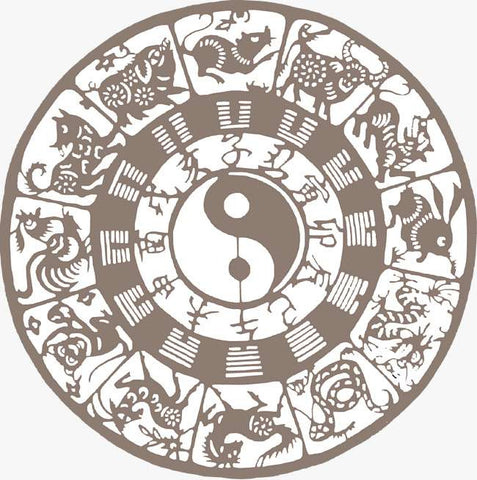About the Culture of Chinese Zodiac
Traditional Chinese culture has a long history. Being a part of it, the zodiac culture has a close relationship with Chinese people’s concept of life, nature, religion and philosophy. The twelve Chinese zodiac signs, are Rat, Ox, Tiger, Rabbit, Dragon, Snake, Horse, Goat, Monkey, Rooster, Dog, and Pig.
Its origin is, according to the literature, the method of measuring years based on the Ten Heavenly Stem and Twelve Earthly Branches, dating from Period of the Emperor Shun in central China, "Chinese zodiac" originated in The Book of Songs, the oldest collection of poems in the world. Chapter Xiaoya, Chegong of The Book of Songs recorded, "In a blessed day of Gengwu, I travel with some well-chosen horse." In The Book of Rite, Chapter Yueling, Jidong, "people make clay ox to drive away the coldness." Some bamboo slips of Qin Dynasty were unearthed in Shuihu Area of Yunmeng County of Hubei Province and Fangma Beach of Tianshui City of Gansu Province, in the middle of the 1970s. They showed that in the early Qin Dynasty, a relatively complete zodiac system was already formed. The records of Chinese zodiac same with nowadays date to Lun Heng, by Wang Chong of East Han Dynasty, Chapter Three, the chapter about the state of things. Liang Zhanggang of Qing Dynasty also quoted the words in Lun Heng about Chinese zodiac in his work Langji Congtan: Xutan.

The twelve Chinese zodiac animals represent the Twelve Earthly Branches: Rat as Zi, Os as Chou, Tiger as Yin, Rabbit as Mao, Dragon as Chen, Snake as Si, Horse as Wu, Goat as Wei, Monkey as Shen, Rooster as You, Dog as Xu, and Pig as Hai. With the development of society, the Chinese zodiac signs are merging with folk beliefs, and each zodiac sign has rich stories and legends. Chinese zodiac provided people’s lives with new cultural elements, as in marriage, career, luck of the year, etc.
Origin of Chinese Zodiac
There are a variety saying about origin of the twelve Chinese zodiac signs, the following are three representative ones.
-
From Totem. The ancestors of primitive society used signs of an animal or a phenomenon to represent the protecting god of their clans, i.e., totems. The Classic of Mountains and Seasrecorded many totem gods from different places in ancient times, which were combined images of men and beasts. Totem of the Xia Clan were bear or fish; of the Shang Clan, Fenice; of the Zhou Clan, dragon, bird, turtle, dog, or tiger according to different literature. All animals in Chinese zodiac, except the illusory dragon were close to people’s daily lives. They could be divided into two groups: six livestock (horse, ox, goat, rooster, dog, pig) and six beasts (rat, tiger, rabbit, dragon, snake, monkey), the former being raised by people for economic reasons, and the later that to a certain degree harass people or put fear into their hearts. Therefore these animals were worshiped as sings of certain clans.

-
From the movement of Jupiter. Jupiter revolves around the sun in a circle of twelve years. Chinese ancestors defined the years by its position in the sky. Ma Guohan in Qing Dynasty, said in his Addendum Book of the house on Yunan Mountain, that every twelve years had " three years of harvest, three years of poor crops, three years of good growing, and three years of drought". Periods occurred in the rise and decline of plants and animals. Herbivores, predators and omnivores had varied living conditions in different years. Ancient people thought that the rise and decline of animals were related to the years marked by Jupiter. They referred the people who were born in a particular year to the animals that thrived in that year. In this way, the zodiac animals came into shape.

- From counting.The number " twelve" of Chinese zodiac correlated with people’s conclusive understanding of natural phenomena. Chinese ancestors found the circle of the change of climate and the growth of plants, so they defined the circle as a " a year". The waxing and waning of moon also went with the circle, thus twelve waxing amounted to a year in time. Chapter " Offices of Spring, Fengxiangshi" in The rites of Zhou recorded, " Twelve years form a circle, and so do twelve months and twelve two-hour periods." The number " twelve" also marked hours, other than years and months. It was also applied in many other fields. The Spring and Autumn Annals, Chapter for Duke Ai of Lu, recorded, "In the Zhou Dynasty, people created the rites if Zhou, adopting a strict hierarchical system for social rites such as clothing and rituals. The Rites of Zhou stipulated that the highest rank is marked by the number twelve ." History of the Spring and Autumn Nations (Guoyu), Jin’s Chapter, recorded," Among the twenty-five sons of the Yellow Emperor, fourteen of them were granted a surname, and in all they had twelve surnames." History of the later Han Dynasty, Chapter of Xun Shuang, recorded," Twelve is the highest number of heaven thus the emperor’s brides should be not more than twelve in number. The number of the duke’s wive decreases according to their positions." Besides, the number twelve existed in all walks of life, for example " the twelve celestial phenomena" referred to all kinds of weather: dark, cloudy, rainy, snowy, icy, foggy, dewy, frosty, windy, sandy, stormy, and lightning: Traditional Chinese medicine held that human body had twelve meridians and collateral; ancient Chinese music had twelve tones; also we had " twelve diets" and " twelve clothing".
Besides, there are also other saying that Chinese zodiac is from the Five Elements and yin-yang, constellation, or foreign nations. The most interesting one is about a contest held by the Jade Emperor to rank the animal.
It was said that thousands of years ago, people had no idea about how to count their ages. So they came to the Jade Emperor for help. The emperor decided to choose twelve animals to represent the zodiac of the people who were born in each year, to count people’s ages. He summoned all the animals, and held a river-crossing contest, bidding that the twelve animals that crossed the river first would be the winners.
During the contest, the rat begged the simple and honest ox which was good at swimming to carry it across the river. When the finishing line was close, it jumped ahead of the ox and became champion, to everyone’s surprise. The ox had to be the second, followed by the tiger. The rabbist hopped on other animals’ back and reached the line in the fourth place. Since it was so nervous about contest, it fell on a giant rock near the river, and cracked its mouth into three pieces. The dragon and the snake were both good at swimming, while the dragon only took the fifth place for it was late for the games. It had been busy at making rain fall for the people to grow their crops. The snake was too proud about its swimming ability, ending up in falling even behind the dragon for the sixth place. The horse, the goat and the monkey took the seventh to the ninth places. The rooster and the dog found a large tree branch, and crossed the river standing on it. The rooster was said to have four legs in the past; it broke two for they were stuck in the tree branch. It got the tenth place. The dog was over-thrilled about watching other animals crossing the river and forgot about its own game, so it fell behind the rooster. At sunset, the pig peacefully crossed the river with its round belly, and took the last position.
Since then, people began to adopt an age counting method involving a twelve-year circle with each animal standing for one year.
You might ask: why wasn’t the cat in the contest? It appeared that it overslept missed the contest. The cat was a good friend to the rat before the story happened. It asked the rat to wake it up for the contest, while the rat didn’t. The cat woke up and hurried for the contest, only to find the twelve winners were holding a celebrating party. Although the rat won the contest, it turned its friend to mortal enemy.
Chinese Zodiac:Folk Tradition, Connotation
Leave a comment